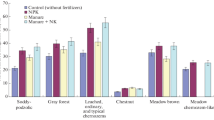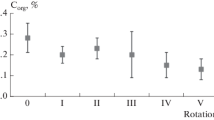Abstract
The agronomic effectiveness of superphosphate and two rock phosphates that had been applied once only to the soil surface 8 to 12 years previously was measured in a field experiment with oats on a lateritic soil in south-western Australia. The soil was either undisturbed or cultivated with a rotary hoe before sowing. The rock phosphates were Christmas Island C-grade ore (C-ore, a calcium ironaluminium rock phosphate), and C-ore calcined (heated) at about 500°C (Calciphos).
Cultivation reduced the effectiveness for all three fertilizers by 20 to 50%. The effectiveness of phosphorus (P) applied as superphosphate decreased with increasing period from time of application whereas the effectiveness of the rock phosphates increased but they were always much less effective than superphosphate.
The relationship between grain yield and P concentration of plant tissue (i.e. the internal efficiency of P use curve) was similar regardless of fertilizer type, year of application of fertilizer, and whether or not the soil was cultivated. Thus differences in fertilizer residual effectiveness were solely due to the amount of P taken up by the plants.
Values of bicarbonate-soluble P (i.e. soil test for P values) for superphosphate treated soil were reduced by about 20 to 25% when the fertilizer was incorporated into the soil whereas for the rock phosphate treated soils the values were little affected by cultivation. The relationship between yield and soil test for P values varied depending on cultivation treatment and fertilizer.
We conclude that cultivation decreases the effectiveness of residual fertilizer P and that cultivation and fertilizer type influence the accuracy of yield prediction from soil test values.
Similar content being viewed by others
References
Alston AM and Chin KW (1974) Response of subterranean clover to rock phosphates as affected by particle size and depth of mixing in the soil. Aust J Exp Agric. Anim Husb 14: 649–655
AOAC (1975) ‘Official Methods of Analysis’ 12 edn. Assoc Of Agric Chem: Washington DC
Barrow NJ (1980) Evaluation and utilization of residual phosphorus in soils. In: Khasawneh FE, Sample EC and Kamprath EJ (eds) The Role of Phosphorus in Agriculture. Ch 13, pp 339–359. Madison: Am Soc Agron
Beckwith RS (1988) Low solubility phosphate fertilizers. Agric Sci 1: 18–26
Benbi DK, Gilkes RJ and Bolland MDA (1988) An assessment of soil tests for phosphate for prediction of cereal yields on a sandy soil in Western Australia. Fert Res 16: 137–155
Bolland MDA and Allen DG (1987) Comparison of three soil tests for phosphate on lateritic soil fertilized with superphosphate, crandallite rock phosphates and apatite rock phosphates. Aust J Soil Res 25: 555–562
Bolland MDA, Allen DG and Gilkes RJ (1989) The influence of seasonal conditions, plant species and fertilizer type on the predictions of plant yields using the Colwell bicarbonate soil test for phosphate. Fert Res 19: 143–158
Bolland MDA and Bowden JW (1986) Summary of long-term rock phosphate experiments in south-western Australia. J Aust Instit Agric Sci 52: 227–235
Bolland MDA, Bowden JW, D'Antuono MF and Gilkes RJ (1984) The current and residual value of superphosphate, Christmas Island C-grade ore, and Calciphos as fertilizers for a subterranean clover pasture. Fert Res 5: 335–354
Bolland MDA and Gilkes RJ (1989) Reactive rock phosphate fertilizers and soil testing for phosphorus: the effect of particle size of the rock phosphate. Fert Res 21: 75–93
Bolland MDA, Gilkes RJ and Allen DG (1988) The residual value of superphosphate and rock phosphates for lateritic soils and its evaluation using three soil phosphate tests. Fert Res 15: 253–280
Bolland MDA, Gilkes RJ and D'Antuono MF (1988) The effectiveness of rock phosphate fertilizers in Australia: a review. Aust J Exp Agric 28: 655–668
Bolland MDA, Weatherley AJ and Gilkes RJ (1989) The long-term residual value of rock phosphate and superphosphate fertilizers for various plant species under field conditions. Fert Res 20: 89–100
Bowden JW and Bennett D (1976) The ‘Decide’ model for predicting superphosphate requirements. Proc Phos Agric Sym 1974. Aust Instit Agric Sci: Parkville Vic Aust
Colwell JD (1963) The estimation of the phosphorus fertilizer requirements of wheat in southern New South Wales by soil analysis. Aust J Exp Agric Anim Husb 3: 190–197
Colwell JD (1985) Fertilizer programmes. I. Variability in response of successive crops to fresh and previous applications of phosphorus fertilizer in Australia and Brazil. Fert Res 8: 21–38
Doak BW, Callaher PJ, Evans L and Muller FB (1965) Low temperature calcination of C-grade phosphate from Christmas Island. NZ J Agric Res 8: 15–29
Gilkes RJ and Palmer B (1979) Calcined Christmas Island C-grade rock phosphate fertilizers: mineralogical properties, reversion and assessment by chemical extraction. Aust J Soil Res 17: 467–481
Hoare J (1980) Phosphate raw materials and fertilizers. II. A case history of marginal raw materials. In: eds Khasawneh FE, Sample EC and Kamprath EJ ‘The Role of Phosphorus in Agriculture’ Ch 4 pp 121–128. Madison: Am Soc Agron
Kanabo IAK and Gilkes RJ (1988) A comparison of mixed and band applications on the dissolution of North Carolina phosphate rock and on bicarbonate-soluble soil phosphorus. Fert Res 15: 3–12
Jones US and Bardsley CE (1968) Phosphorus Nutrition. pp 213–254In: eds FC Elliot, M Hoover and WK Porter Jr Advances in Production and Utilization of Quality Cotton: Principles and Practices. Iowa State University Press, Ames
Kaita S and Steffens D (1989) Einfluss des Bodengefüges auf Wurzelwachtstum und Phosphataufnahme von Sommer weizen. Z Pflanzenernahr Bodenk 152: 345–350
Khasawneh FE and Doll EC (1978) The use of phosphate rock for direct applications to soils. Adv Agron 30: 159–206
Lipsett J and Williams CH (1970) Evaluation of Christmas Island C-grade phosphate as a fertilizer on some soils in southern New South Wales. Aust J Exp Agric Anim Husb 10: 783–789
Mason MG and Cox WJ (1969) Calcined rock phosphate as a fertilizer for pasture and cereal production in Western Australia. Aust J Exp Agric Anim Husb 9: 99–104
Ozanne PG and Shaw TC (1967) Phosphate sorption by soils as a measure of the phosphate requirement for pasture growth. Aust J Agric Res 18: 601–612
Ross GJS (1980) ‘MLP Maximum Likelihood Programme’. Rothamsted Exp Stat: Harpenden, UK
Sale PWG and Blair GJ (1989) Low solubility phosphate fertilizers for pastures: an alternative prospect. Agric Sci 2: 34–39
Terman GL, Moreno EC and Osborne G (1964) Acidulation of phosphate rock in soil. Soil Sci Soc Am Proc 28: 104–107
Williams CH and Simpson JR (1965) Some effects of cultivation and waterlogging on the availability of phosphorus in pasture soils. Aust J Agric Res 16: 413–427
Yost RS, Kamprath EJ, Lobato E and Naderman G (1979) Phosphorus response of corn on an oxisol as influenced by rates and placement. Soil Sci Soc Am J 43: 338–343
van der Paauw F (1965) Factors controlling the efficiency of rock phosphates for potatoes and rye on humic sandy soils. Plant and Soil 22: 81–98
Author information
Authors and Affiliations
Rights and permissions
About this article
Cite this article
Bolland, M.D.A., Gilkes, R.J. Cultivation reduces fertilizer residual effectiveness and affects soil testing for available phosphorus. Fertilizer Research 24, 33–46 (1990). https://doi.org/10.1007/BF01073144
Received:
Accepted:
Issue Date:
DOI: https://doi.org/10.1007/BF01073144




